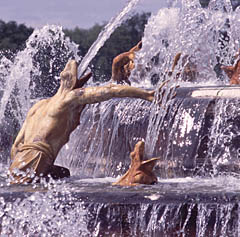
The water master in Versailles is the last "lord of the waters" in France
 |
Bultez stumbled into his extraordinary job somewhat by chance when he answered an ad five years ago, looking for the chief water manager of the Versailles waterworks. Since then, he has led a team of 13 people who are responsible for the maintenance of 35 pools and 30 kilometers of sewers that have remained almost in their original form since their creation.
The system, which the somewhat reserved engineer describes as "insanely sophisticated," is the result of the long work of André Le Nôtre, who was the royal landscape architect, and the Italian brothers - the Francine water engineers.
"In the 17th century, waterworks were popular, and in Versailles, as a seat of political propaganda, it was necessary to tame this element. It took fifty years of work to supply enough water to nourish the fountains," Bultez stated.
The town of Versailles, which is located near Paris, was indeed poor in water. Therefore, engineers devised a bold system of pumping and retaining water that brought moisture from as far away as 30 kilometers.
The work of the head of Versailles waters has not changed much since then. The main season starts in April when the largest fountains, created back in 1666, are turned on. In the 19th century, they became "musical," and since then, they play every summer. Water managers illuminate the entire vast facility every weekend so that the fountains can "dance" to the rhythm of French Baroque.
"The grand water festivals are the culmination of year-round work that must remain hidden from tourists, just as it was the case for the king," Bultez enthusiastically recounts. For him, a water manager in Versailles is the "man behind the scenes," with a very complex and intricate mission. He often works in dark underground spaces, in winter, with his hands in the mud... The sewers around the fountains are not visible, as they are led underground. The above-ground part of the network is accessible via dug terraces on a hill by the Latona fountain.
The "science" of water management lies in dosing. "The main thing is to know how to open the sluices correctly. You must be able to maintain stable pressure, release water evenly, then you will be able to control the quantity, speed, and height of the flow," Bultez indicated.
Finance Minister Jean-Baptiste Colbert even detailed the operating rules of each fountain in his time so that they could be regulated according to the king's movements. His slightest walk would be an opportunity to start the water ballet.
Today, Gilles Bultez is not interested in the connection between politics and the work of art; instead, he has focused on the restoration of the Groves of the Three Fountains (Bosquet des trois fontaines), which, as the name suggests, features three cascaded fountains. There are no statues here; it is a pure connection of greenery and masterfully controlled water element. "This is not about propaganda, but about the concentrated work of André Le Nôtre," Bultez concluded.
The English translation is powered by AI tool. Switch to Czech to view the original text source.
0 comments
add comment






